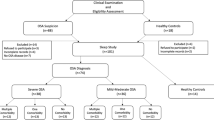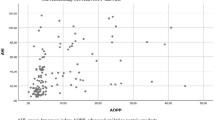Abstract
Pupose
Obstructive sleep apnea (OSA) is associated with various metabolic disorders, and oxidative stress was suggested to play an important role. In the present study, we aimed to investigate serum adiponectin and oxidative stress markers, especially protein carbonyls, and to evaluate the correlation between these parameters and lipid, insulin and fasting glucose concentrations in OSA patients and controls.
Method
Blood was drawn from healthy male volunteers following full-night polysomnographic evaluation. Subjects were classified as controls (n = 24), mild OSA group (n = 9) and moderate-severe OSA group (n = 17) according to their apnea–hypopnea indices (AHIs). Serum lipids, fasting glucose, adiponectin, malondialdehyde (MDA), protein carbonyl concentrations, and paraoxonase activities were measured in all subjects.
Results
Results of this study indicated that serum adiponectin concentrations were significantly decreased and MDA and protein carbonyl concentrations were significantly elevated in OSA patients compared to the controls. Protein carbonyl and MDA concentrations were significantly and positively correlated with AHI, while a significant negative correlation was found between adiponectin concentrations and AHI. Adiponectin levels were negatively correlated with MDA levels.
Conclusion
Results of this study, which is the first human study investigating and describing serum protein carbonyl concentrations in OSA patients, reveal that OSA causes increments in oxidative damage and decreases adiponectin levels. The recurrent hypoxia-reoxygenation attacks in OSA patients may activate oxidative stress, elevating sympathetic activity and leading to low levels of adiponectin.

Similar content being viewed by others
References
Carpagnano GE, Kharitonov SA, Resta O, Foschino-Barbaro MP, Gramiccioni E, Barnes PJ (2003) 8-Isoprostane, a marker of oxidative stress, is increased in exhaled breath condensate of patients with obstructive sleep apnea after night is reduced by continious positive air way pressure therapy. Chest 124:1386–1392
Christou K, Markoulis N, Moulas AN, Pastaka C, Gourgoulianis KI (2003) Reactive oxygen metabolites (ROMs) as an index of oxidative stress in obstructive sleep apnea patients. Sleep Breath 7:105–110
Saarelainen S, Lehtimaki T, Jaak-Kola O, Poussa T, Nikkila M, Solakivi T, Nieminen MM (1996) Autoantibodies against oxidised low-density lipoprotein in patients with obstructive sleep apneoea. Clin Chem Lab Med 37:517–520
Jordan W, Berger C, Cohrs S, Rodenbeck A, Mayer G, Niedmann PD, vanAhsen N, Rüther E, Kornhuber J, Bleich S (2004) CPAP-therapy efficiently lowers serum homocysteine in obstructive sleep apnea syndrome. J Neural Transm 111:683–689
Lavie L (2003) Obstructive sleep apnoea syndrome—an oxidative stress disorder. Sleep Med Rev 7:35–51
Banno K, Kryger MH (2007) Sleep apnea: clinical investigations in humans. Sleep Med 8:400–426
Ip MS, Lam B, Ng MM, Lam WK, Tsang KW, Lam KS (2002) Obstructive sleep apnea is independently associated with insulin resistance. Am J Respir Crit Care Med 165:670–676
Punjabi NM, Sorkin JD, Katzel LI, Goldberg AP, Schwartz AR, Smith PL (2002) Sleepdisordered breathing and insulin resistance in middle-aged and overweight men. Am J Respir Crit Care Med 165:677–682
Meslier N, Gagnadoux F, Giraud P, Person C, Ouksel H, Urban T, Racineux J-L (2003) Impaired glucose-insulin metabolism in males with obstructive sleep apnoea syndrome. Eur Respir J 22:156–160
Newman AB, Nieto FJ, Guidry U, Lind BK, Redline S, Shahar E, Pickering TG, Quan SF (2001) Sleep Heart Health Study Research Group. Relation of sleepdisordered breathing to cardiovascular disease risk factors: the Sleep Heart Health Study. Am J Epidemiol 154:50–59
McArdle N, Hillman D, Beilin L, Watts G (2007) Metabolic risk factors for vascular disease in obstructive sleep apnea: a matched controlled study. Am J Respir Crit Care Med 175:190–195
Tan KC, Chowa W-S, Lama JC, Lama B, Wong W-K, Tamb S, Ipl MS (2006) HDL dysfunction in obstructive sleep apnea. Atherosclerosis 184:377–382
Sharma SK, Kumpawat S, Goel A, Banga A, Ramakrishnan L, Chaturvedi P (2007) Obesity and not obstructive sleep apnea is responsible for metabolic abnormalities in a cohort with sleep disordered breathing. Sleep Medicine 8:12–17
Ciftci TU, Kokturk O, Bukan N, Bilgihan A (2005) Leptin and ghrelin levels in patients with obstructive sleep apnea syndrome. Respiration 72:395–401
Punjabi NM, Sorkin JD, Katzel LI, Goldberg AP, Schwartz AR, Smith PL (2002) Sleep-disordered breathing and insulin resistance in middle-aged and overweight men. Am J Respir Crit Care Med 165:677–682
Punjabi NM, Shahar E, Redline S, Gottlieb DJ, Givelber R, Resnick HE (2004) Sleep Heart Health Study Investigators. Sleepdisordered breathing, glucose intolerance, and insulin resistance: the sleep heart health Study. Am J Epidemiol 160:521–530
Lihn AS, Pedersen SB, Richelsen B (2005) Adiponectin: action, regulation and association to insulin sensitivity. Obes Rev 6:13–21
Fantuzzi G (2005) Adipose tissue, adipokines, and inflammation. J Allergy Clin Immunol 115:911–919
Masserini B, Morpurgo PS, Donadio F, Baldessari C, Bossi R, Beck-Peccoz P, Orsi E (2006) Reduced levels of adiponectin in sleep apnea syndrome. J Endocrinol Invest 29:700–705
Harsch IA, Schahin SP, Radespiel-Tröger M, Weintz O, Jahreiss H, Fuchs FS, Wiest GH, Hahn EG, Lohmann T, Konturek PC, Ficker JH (2004) Continious positive airway pressure tratment rapidly improves insulin sensitivity in patients with obstructive sleep apnea syndrome. Am J Respir Crit Care Med 169:156–162
Makino S, Handa H, Suzukawa K, Fujiwara M, Nakamura M, Muraoka S, Takasago I, Tanaka Y, Hashimato K, Sugimoto T (2006) Obstructive sleep apnoea syndrome, plasma adiponectin levels, and insulin resistance. Clin Endocrinol 64:12–19
Young T, Palta M, Dempsey J, Skatrud J, Weber S, Badr S (1993) The occurrence of sleep-disordered breathing among middle-aged adults. N Engl J Med 328:1230–1235
Banno K, Walld R, Kryger MH (2005) Increasing obesity trends in patients with sleep breathing disorders referred to a sleep disorders centre. J Clin Sleep Med 1:364–366
Vgontzas AN, Papanicolaou DA, Bixler EO, Kales A, Tyson K, Chrousos GP (1997) Elevation of plasma cytokines in disorders of excessive daytime sleepiness: role of sleep disturbance and obesity. J Clin Endocrinol Metab 82:1313–1316
Soares AF, Guichardant M, Cozzone D, Bernoud-Hubac N, Bouzaïdi-Tiali N, Lagarde M, Géloën A (2005) Effects of oxidative stress on adiponectin secretion and lactate production in 3T3-L1 adipocytes. Free Radic Biol Med 38:882–889
Matthews DR, Hosker JP, Rudenski AS, Naylor BA, Treacher DF, Turner RC (1985) Homeostasis model assessment: insulin resistance and beta-cell function from fasting plasma glucose and insulin concentrations in man. Diabetologia 28:412–419
Young IS, Trimble ER (1991) Measurement of malondialdehyde in plasma by high performance liquid chromatography with fluorimetric detection. Ann Clin Biochem 28:504–508
Reznick AZ, Packer L (1994) Oxidative damage to proteins: spectrophotometric method for carbonyl assay. Methods Enzymol 233:357–363
Eckerson HW, Wyte CM, La Du BN (1983) The human serum paraoxonase/arylesterase polymorphism. Am J Hum Genet 35:1126–1138
Lavie L, Vishnevsky A, Lavie P (2004) Evidence for lipid peroxidation in obstructive sleep apnea. Sleep 27:123–128
Barcelo A, Miralles C, Barbe F, Vila M, Pons S, Agusti AG (2000) Abnormal lipid peroxidation in patients with sleep apnoea. Eur Respir J 16:644–647
Itzhaki S, Dorchin H, Clark G, Lavie L, Lavie P, Pillar G (2007) The effects of 1-year treatment with a herbst mandibular advancement splint on obstructive sleep apnea, oxidative stress, and endothelial function. Chest 131:740–749
Lavie L (2005) Sleep-disordered breathing and cerebrovascular disease: a mechanistic approach. Neurol Clin 23:1059–1075
Suzuki YJ, Jain V, Park AM, Day RM (2006) Oxidative stress and oxidant signaling in obstructive sleep apnea and associated cardiovascular diseases. Free Radic Biol Med 40:1683–1692
Arnardottir ES, Mackiewicz M, Gislason T, Teff KL, Pack AI (2009) Molecular sigantures of obstructive sleep apnea in adults: a riview and perspective. Sleep 32:447–470
Sonka K, Fialová L, Volná J, Jiroutek P, Vávrová J, Kemlink D, Pretl M, Kalousová M (2008) Advanced oxidation protein products in obstructive sleep apnea. Prague Med Rep 109:159–165
Tanriverdi H, Evrengul H, Kuru O, Tanriverdi S, Seleci D, Enli Y, Kaftan HA, Kilic M (2006) Cigarette smoking induced oxidative stress may impair endothelial function and coronary blood flow in angiographically normal coronary arteries. Circ J 70(5):593–599
Lavie P (2004) Evidence for lipid peroxidation in obstructive sleep apnea. Sleep 27(1):123–8
Trujillo ME, Scherer PE (2005) Adiponectin—journey from an adipocyte secretory protein to biomarker of the metabolic syndrome. J Intern Med 257:167–175
Buckley TM, Schatzberg AF (2005) On the interactions of the hypothalamic–pituitary–adrenal (HPA) axis and sleep: normal HPA axis activity and circadian rythm, exemplary sleep disorders. J Clin Endocrinol Metab 90:3106–3114
Bruun JM, Lihn AS, Verdich C, Pedersen SB, Toubro S, Astrup A, Richelsen B (2003) Regulation of adiponectin by adipose tissue-derived cytokines: in vivo and in vitro investigations in humans. Am J Physiol Endocrinol Metab 285:527–533
Author information
Authors and Affiliations
Corresponding author
Rights and permissions
About this article
Cite this article
Vatansever, E., Surmen-Gur, E., Ursavas, A. et al. Obstructive sleep apnea causes oxidative damage to plasma lipids and proteins and decreases adiponectin levels. Sleep Breath 15, 275–282 (2011). https://doi.org/10.1007/s11325-010-0378-8
Received:
Revised:
Accepted:
Published:
Issue Date:
DOI: https://doi.org/10.1007/s11325-010-0378-8




